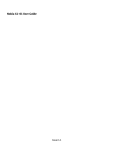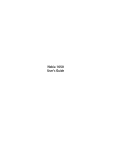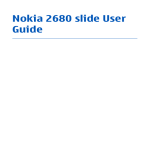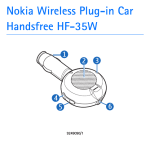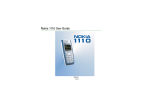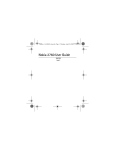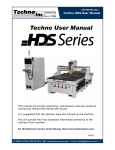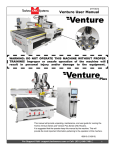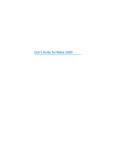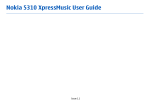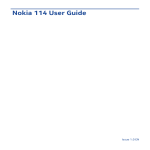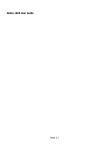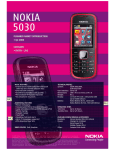Download PDF Nokia 1208 User Guide
Transcript
Nokia 1200/1208 User’s Guide Copyright © 2007 Nokia. All rights reserved. 0434 DECLARATION OF CONFORMITY Hereby, NOKIA CORPORATION declares that this RH-99/RH-105 product is in compliance with the essential requirements and other relevant provisions of Directive 1999/5/EC. A copy of the Declaration of Conformity can be found at http://www.nokia.com/phones/ declaration_of_conformity/. © 2007 Nokia. All rights reserved. Nokia, Nokia Connecting People, and Navi are trademarks or registered trademarks of Nokia Corporation. Nokia tune is a sound mark of Nokia Corporation. Other product and company names mentioned herein may be trademarks or tradenames of their respective owners. Reproduction, transfer, distribution, or storage of part or all of the contents in this document in any form without the prior written permission of Nokia is prohibited. US Patent No 5818437 and other pending patents. T9 text input software Copyright © 1997-2007. Tegic Communications, Inc. All rights reserved. Nokia operates a policy of ongoing development. Nokia reserves the right to make changes and improvements to any of the products described in this document without prior notice. TO THE MAXIMUM EXTENT PERMITTED BY APPLICABLE LAW, UNDER NO CIRCUMSTANCES SHALL NOKIA OR ANY OF ITS LICENSORS BE RESPONSIBLE FOR ANY LOSS OF DATA OR INCOME OR ANY SPECIAL, INCIDENTAL, CONSEQUENTIAL OR INDIRECT DAMAGES HOWSOEVER CAUSED. Copyright © 2007 Nokia. All rights reserved. i THE CONTENTS OF THIS DOCUMENT ARE PROVIDED “AS IS”. EXCEPT AS REQUIRED BY APPLICABLE LAW, NO WARRANTIES OF ANY KIND, EITHER EXPRESS OR IMPLIED, INCLUDING, BUT NOT LIMITED TO, THE IMPLIED WARRANTIES OF MERCHANTABILITY AND FITNESS FOR A PARTICULAR PURPOSE, ARE MADE IN RELATION TO THE ACCURACY, RELIABILITY OR CONTENTS OF THIS DOCUMENT. NOKIA RESERVES THE RIGHT TO REVISE THIS DOCUMENT OR WITHDRAW IT AT ANY TIME WITHOUT PRIOR NOTICE. The availability of particular products and applications and services for these products may vary by region. Please check with your Nokia dealer for details, and availability of language options. This device may contain commodities, technology or software subject to export laws and regulations from the US and other countries. Diversion contrary to law is prohibited. ii Copyright © 2007 Nokia. All rights reserved. Contents For your safety ................. iv About your device ................ vii Network services ................. viii 1. Get started.................... 1 Install the SIM card and battery ....................................... 1 Charge the battery................. 3 Switch on and off................... 4 2. Your phone ................... 6 Keys and parts......................... 6 Main features .......................... 7 Make and answer a call........ 8 Loudspeaker ............................. 8 Write text ................................. 8 Message .................................... 9 Contacts................................. 11 Flashlight ............................... 11 Multi-phonebook ................ 12 3. Battery information... 13 Charging and discharging. 13 Nokia battery authentication guidelines .............................. 15 4. Genuine Enhancements................. 19 Battery .................................... 20 Nokia Mobile Charger (DC-4)...................................... 22 Nokia Battery Charging Stand (DT-14)........................ 22 Audio ....................................... 22 Care and maintenance ... 23 Additional safety information ..................... 25 Small children ....................... 25 Operating environment ...... 25 Medical devices .................... 26 Vehicles................................... 27 Potentially explosive environments....................................... 29 Emergency calls.................... 30 Certification information (SAR)........................................ 31 Index ................................ 33 Copyright © 2007 Nokia. All rights reserved. iii For your safety Read these simple guidelines. Not following them may be dangerous or illegal. Read the complete user guide for further information. SWITCH ON SAFELY Do not switch the device on when wireless phone use is prohibited or when it may cause interference or danger. ROAD SAFETY COMES FIRST Obey all local laws. Always keep your hands free to operate the vehicle while driving. Your first consideration while driving should be road safety. INTERFERENCE All wireless devices may be susceptible to interference, which could affect performance. SWITCH OFF IN HOSPITALS Follow any restrictions. Switch the device off near medical equipment. iv Copyright © 2007 Nokia. All rights reserved. SWITCH OFF IN AIRCRAFT Follow any restrictions. Wireless devices can cause interference in aircraft. SWITCH OFF WHEN REFUELING Do not use the device at a refueling point. Do not use near fuel or chemicals. SWITCH OFF NEAR BLASTING Follow any restrictions. Do not use the device where blasting is in progress. USE SENSIBLY Use only in the positions as explained in the product documentation. Do not touch the antenna areas unnecessarily. QUALIFIED SERVICE Only qualified personnel may install or repair this product. ENHANCEMENTS AND BATTERIES Use only approved enhancements and batteries. Do not connect incompatible products. Copyright © 2007 Nokia. All rights reserved. v WATER-RESISTANCE Your device is not water-resistant. Keep it dry. BACK-UP COPIES Remember to make back-up copies or keep a written record of all important information stored in your device. CONNECTING TO OTHER DEVICES When connecting to any other device, read its user guide for detailed safety instructions. Do not connect incompatible products. EMERGENCY CALLS Ensure the phone function of the device is switched on and in service. Press the end key as many times as needed to clear the display and return to the standby mode. Enter the emergency number, then press the call key. Give your location. Do not end the call until given permission to do so. vi Copyright © 2007 Nokia. All rights reserved. ■ About your device The wireless device described in this guide is approved for use on the GSM 900 and GSM 1800 networks. Contact your service provider for more information about networks. When using the features in this device, obey all laws and respect local customs, privacy and legitimate rights of others, including copyrights. Warning: To use any features in this device, other than the alarm clock, the device must be switched on. Do not switch the device on when wireless device use may cause interference or danger. Copyright © 2007 Nokia. All rights reserved. vii ■ Network services To use the phone you must have service from a wireless service provider. Many of the features require special network features. These features are not available on all networks; other networks may require that you make specific arrangements with your service provider before you can use the network services. Your service provider can give you instructions and explain what charges will apply. Some networks may have limitations that affect how you can use network services. For instance, some networks may not support all language-dependent characters and services. Your service provider may have requested that certain features be disabled or not activated in your device. If so, these features will not appear on your device menu. Your device may also have a special configuration such as changes in menu names, menu order, and icons. Contact your service provider for more information. viii Copyright © 2007 Nokia. All rights reserved. Get started 1. Get started ■ Install the SIM card and battery Always switch the device off and disconnect the charger before removing the battery. Keep all SIM cards out of the reach of small children. For availability and information on using SIM card services, contact your SIM card vendor. This may be the service provider, network operator, or other vendor. This phone is intended for use with the BL-5CA battery. 1. Slide the back cover to remove it (1). Lift the battery, and remove it (2). 2. Carefully lift the SIM card holder from the finger grip of the phone (3). Insert the SIM card into the holder, so that the beveled corner is on the upper right side and the gold-colored contact area is facing downward (4). Close the SIM card holder, and press it to lock it into place (5). Copyright © 2007 Nokia. All rights reserved. 1 Get started 3. Replace the battery and back cover (6, 7). Note: Always switch off the power and disconnect the charger and any other device before removing the covers. Avoid touching electronic components while changing the covers. Always store and use the device with the covers attached. 2 Copyright © 2007 Nokia. All rights reserved. Get started ■ Charge the battery Warning: Use only batteries, chargers, and enhancements approved by Nokia for use with this particular model. The use of any other types may invalidate any approval or warranty, and may be dangerous. Check the model number of any charger before use with this device. This device is intended for use when supplied with power from an AC-3 charger. For availability of approved enhancements, please check with your dealer. When you disconnect the power cord of any enhancement, grasp and pull the plug, not the cord. 1. Connect the charger to a wall outlet. 2. Connect the charger to the phone. The battery indicator bar starts scrolling. When the battery is fully charged, the bar stops scrolling. Tip: To save energy, unplug the charger when the battery is fully charged. Copyright © 2007 Nokia. All rights reserved. 3 Get started If the battery is completely discharged, it may take a few minutes before the charging indicator appears on the display or before any calls can be made. ■ Switch on and off Press and hold the end key. Use the phone only in its normal operating position. Your device has an internal antenna. Note: As with any radio transmitting device, avoid touching an antenna unnecessarily when the antenna is in use. For example, avoid touching the cellular antenna during a phone call. Contact with a transmitting or receiving antenna affects the quality of the radio communication, may cause the device to operate at a higher power level than otherwise needed, and may reduce the battery life. 4 Copyright © 2007 Nokia. All rights reserved. Get started Note: Do not touch this connector as it is intended for use by authorized service personnel only. Copyright © 2007 Nokia. All rights reserved. 5 Your phone 2. Your phone ■ Keys and parts • Network name or operator logo (1) • Network signal strength (2) • Battery charge level (3) • Earpiece (4) • Loudspeaker (5) • Flashlight (6) • Selection key functions (7) • Selection keys (8) • Navi™ key (9), hereinafter scroll key • Call key (10) • End key/power key (11) • Keypad (12) • Charger connector (13) • Headset connector (14) 6 Copyright © 2007 Nokia. All rights reserved. Your phone ■ Main features Select Menu to access the following features: Messages—to create, send, open, and manage messages Contacts—to save names and phone numbers in the SIM card and phone memory Call register—to access phone numbers of missed, received, and dialed calls Settings—to set up various features of your phone Alarm clock—to set the time for the alarm Reminders—to manage reminders Games—to set up game effects or play the games installed in your phone Extras—to access Calculator, Converter, Countd. tim., Calendar, Stopwatch, Composer, Demo, and Flashlight SIM services—to use additional services, if supported by your SIM card Copyright © 2007 Nokia. All rights reserved. 7 Your phone ■ Make and answer a call To make a call, enter the phone number, including the country code and area code if necessary. Press the call key to call the number. Scroll right to increase or left to decrease the volume of the earpiece or headset during the phone call. To answer an incoming call, press the call key. To reject the call without answering, press the end key. ■ Loudspeaker If available, you may select Loudsp. or Hands. to use the loudspeaker or the earpiece of the phone during a call. Warning: Do not hold the device near your ear when the loudspeaker is in use, because the volume may be extremely loud. ■ Write text You can enter text using traditional text input or predictive text input . To use traditional text input, press the key repeatedly until the letter appears. To turn on predictive text input when writing, select Options > Dictionary and the desired 8 Copyright © 2007 Nokia. All rights reserved. Your phone language; to turn it off, select Options > Dictionary > Dictionary off. When using predictive text input, press each key once for a single letter. If the displayed word is the one you want, press 0, and start writing the next word. To change the word, press * repeatedly until the word you want appears. If ? is displayed after the word, the word is not in the dictionary. To add the word to the dictionary, select Spell, enter the word (using traditional text input), and select OK. Tips for writing text: to add a space, press 0. To quickly change the text input method, press # repeatedly, and check the indicator at the top of the display. To add a number, press and hold the desired number key. To get a list of special characters when using traditional text input, press *; when using predictive text input, press and hold *. To undo the clearing of the message in editing window, select Options > Undo clear. ■ Message The message services can only be used if they are supported by your network or service provider. Your device supports the sending of text messages beyond the character limit for a single message. Longer messages are sent as Copyright © 2007 Nokia. All rights reserved. 9 Your phone a series of two or more messages. Your service provider may charge accordingly. Characters that use accents or other marks, and characters from some language options like Chinese, take up more space limiting the number of characters that can be sent in a single message. 1. Select Menu > Messages > Create message. 2. Write the message. 3. To send the message, select Options > Send, enter the recipient’s phone number, and select OK. Note: Your device may indicate that your message was sent to the message center number programmed into your device. Your device may not indicate whether the message is received at the intended destination. For more details about messaging services, contact your service provider. To delete all read messages or all the messages in a folder, select Menu > Messages > Delete messages > All read or the desired folder. 10 Copyright © 2007 Nokia. All rights reserved. Your phone ■ Contacts You can save names and phone numbers in the phone memory and in the SIM card memory. The internal phone book can store up to 200 names. To search for a contact, scroll down in the standby mode, and enter the first letters of the name. Scroll to the name that you want. You can also select Menu > Contacts and from the following options: Add contact—to save names and phone numbers in the phone book Copy—to copy names and phone numbers all at once or one by one from the internal phone book to the SIM phone book, or vice versa ■ Flashlight To turn the flashlight on or off, select Menu > Extras > Flashlight > On or Off. Copyright © 2007 Nokia. All rights reserved. 11 Your phone ■ Multi-phonebook Your phone supports up to five separate phonebooks for multiple users. When the multi-phonebook is activated, only the contacts in the active phonebook are visible. To activate the multi-phonebook, select Menu > Contacts > Settings > Multi-Phonebook > Phonebook style > MultiPhonebk.. To activate a phonebook, select Menu > Contacts > Settings > Multi-Phonebook > Current phonebook and the desired phonebook or Shared cont.. A contact can belong to one or several phonebooks. The contacts in Shared cont. are accessible from all phonebooks. To assign a contact to one or several phonebooks, select Menu > Contacts > Settings > Multi-Phonebook > Manage contacts. Scroll to the desired contact, and select it. Mark the phonebooks in which you want to save the contact, and select Done > Yes. To rename the phonebooks, select Menu > Contacts > Settings > Multi-Phonebook > Rename phonebooks and the desired phonebook. 12 Copyright © 2007 Nokia. All rights reserved. Battery information 3. Battery information ■ Charging and discharging Your device is powered by a rechargeable battery. The battery can be charged and discharged hundreds of times, but it will eventually wear out. When the talk and standby times are noticeably shorter than normal, replace the battery. Use only Nokia approved batteries, and recharge your battery only with Nokia approved chargers designated for this device. If a replacement battery is being used for the first time or if the battery has not been used for a prolonged period, it may be necessary to connect the charger, then disconnect and reconnect it to begin charging the battery. Unplug the charger from the electrical plug and the device when not in use. Do not leave a fully charged battery connected to a charger, since overcharging may shorten its lifetime. If left unused, a fully charged battery will lose its charge over time. If the battery is completely discharged, it may take several minutes before the charging indicator appears on the display or before any calls can be made. Copyright © 2007 Nokia. All rights reserved. 13 Battery information Use the battery only for its intended purpose. Never use any charger or battery that is damaged. Do not short-circuit the battery. Accidental short-circuiting can occur when a metallic object such as a coin, clip, or pen causes direct connection of the positive (+) and negative (-) terminals of the battery. (These look like metal strips on the battery). This might happen, for example, when you carry a spare battery in your pocket or purse. Short-circuiting the terminals may damage the battery or the connecting object. Leaving the battery in hot or cold places, such as in a closed car in summer or winter conditions, will reduce the capacity and lifetime of the battery. Always try to keep the battery between 15°C and 25°C (59°F and 77°F). A device with a hot or cold battery may not work temporarily, even when the battery is fully charged. Battery performance is particularly limited in temperatures well below freezing. Do not dispose of batteries in a fire as they may explode. Batteries may also explode if damaged. Dispose of batteries according to local regulations. Please recycle when possible. Do not dispose as household waste. 14 Copyright © 2007 Nokia. All rights reserved. Battery information Do not dismantle or shred cells or batteries. In the event of a battery leak, do not allow the liquid to come in contact with the skin or eyes. In the event of such a leak, flush your skin or eyes immediately with water, or seek medical help. ■ Nokia battery authentication guidelines Always use original Nokia batteries for your safety. To check that you are getting an original Nokia battery, purchase it from an authorized Nokia dealer, look for the Nokia Original Enhancements logo on the packaging, and inspect the hologram label using the following steps: Successful completion of the four steps is not a total assurance of the authenticity of the battery. If you have any reason to believe that your battery is not an authentic original Nokia battery, you should refrain from using it and take it to the nearest authorized Nokia service point or dealer for assistance. Your authorized Nokia service point or dealer will inspect the battery for authenticity. If authenticity cannot be verified, return the battery to the place of purchase. Copyright © 2007 Nokia. All rights reserved. 15 Battery information Authenticate hologram 1. When looking at the hologram on the label, you should see the Nokia connecting hands symbol from one angle and the Nokia Original Enhancements logo when looking from another angle. 2. When you angle the hologram left, right, down, and up, you should see 1, 2, 3, and 4 dots on each side respectively. 3. Scratch the side of the label to reveal a 20-digit code, for example, 12345678919876543210. Turn the battery so that the numbers are facing upwards. The 20-digit code reads starting from the number at the top row followed by the bottom row. 16 Copyright © 2007 Nokia. All rights reserved. Battery information 4. Confirm that the 20-digit code is valid by following the instructions at www.nokia-asia.com/batterycheck. To create a text message, enter the 20-digit code, for example, 12345678919876543210, and send to +44 7786 200276. To create a text message, do the following: • For countries in Asia Pacific excluding India: Enter the 20-digit code, for example, 12345678919876543210, and send to +61 427151515. • For India only: Enter “Battery” followed by the 20-digit battery code, for example, Battery 12345678919876543210, and send to 5555. National and international operator charges will apply. You should receive a message indicating whether the code can be authenticated. Copyright © 2007 Nokia. All rights reserved. 17 Battery information What if your battery is not authentic? If you cannot confirm that your Nokia battery with the hologram on the label is an authentic Nokia battery, please do not use the battery. Take it to the nearest authorized Nokia service point or dealer for assistance. The use of a battery that is not approved by the manufacturer may be dangerous and may result in poor performance and damage to your device and its enhancements. It may also invalidate any approval or warranty applying to the device. To find out more about original Nokia batteries, visit www.nokia-asia.com/batterycheck. 18 Copyright © 2007 Nokia. All rights reserved. Genuine Enhancements 4. Genuine Enhancements A new extensive range of enhancements is available for your phone. Select the enhancements which accommodate your specific communication needs. Some of the enhancements are described in detail below. For availability of the enhancements, please check with your local dealer. A few practical rules about accessories and enhancements. • Keep all accessories and enhancements out of the reach of small children. • When you disconnect the power cord of any accessory or enhancement, grasp and pull the plug, not the cord. • Check regularly that enhancements installed in a vehicle are mounted and are operating properly. • Installation of any complex car enhancements must be made by qualified personnel only. Copyright © 2007 Nokia. All rights reserved. 19 Genuine Enhancements Use only batteries, chargers and enhancements approved by the phone manufacturer. The use of any other types may invalidate any approval or warranty applying to the phone, and may be dangerous. ■ Battery N1200 Best Performance Type Talktime* Standby time* BL-5CA up to 7 hours up to 390 hours Type Talktime Standby time BL-5CA 3.5 hours 370 hours 20 Copyright © 2007 Nokia. All rights reserved. ECTEL Genuine Enhancements N1208 Best Performance Type Talktime* Standby time* BL-5CA up to 7 hours up to 365 hours Type Talktime Standby time BL-5CA 3.5 hours 350 hours ECTEL * Variation in operation times may occur depending on SIM card, network and usage settings, usage style and environments. Use of FM radio and integrated hands-free will affect talktime and standby. Copyright © 2007 Nokia. All rights reserved. 21 Genuine Enhancements ■ Nokia Mobile Charger (DC-4) This multi-voltage charger with smaller charging plug can be plugged into a cigarette lighter to charge your phone battery. ■ Nokia Battery Charging Stand (DT-14) The stylish Nokia Battery Charging Stand DT-14 is an easy and convenient way to charge a spare phone battery. ■ Audio Nokia Stereo Headset (HS-47) Nokia Stereo Headset HS-47 provides a convenient handsfree solution. Practical answer/end button for managing the calls. Headset enables listening to your compatible Nokia phone's FM radio and Music Player in stereo. Extend the compatibility with included Nokia AV Adapter AD-53. 22 Copyright © 2007 Nokia. All rights reserved. Care and maintenance Care and maintenance Your device is a product of superior design and craftsmanship and should be treated with care. The following suggestions will help you protect your warranty coverage. • Keep the device dry. Precipitation, humidity, and all types of liquids or moisture can contain minerals that will corrode electronic circuits. If your device does get wet, remove the battery, and allow the device to dry completely before replacing it. • Do not use or store the device in dusty, dirty areas. Its moving parts and electronic components can be damaged. • Do not store the device in hot areas. High temperatures can shorten the life of electronic devices, damage batteries, and warp or melt certain plastics. • Do not store the device in cold areas. When the device returns to its normal temperature, moisture can form inside the device and damage electronic circuit boards. • Do not attempt to open the device other than as instructed in this guide. Copyright © 2007 Nokia. All rights reserved. 23 Care and maintenance • Do not drop, knock, or shake the device. Rough handling can break internal circuit boards and fine mechanics. • Do not use harsh chemicals, cleaning solvents, or strong detergents to clean the device. • Do not paint the device. Paint can clog the moving parts and prevent proper operation. • Use only the supplied or an approved replacement antenna. Unauthorized antennas, modifications, or attachments could damage the device and may violate regulations governing radio devices. • Use chargers indoors. • Always create a backup of data you want to keep, such as contacts and calendar notes. • To reset the device from time to time for optimum performance, power off the device and remove the battery. These suggestions apply equally to your device, battery, charger, or any enhancement. If any device is not working properly, take it to the nearest authorized service facility for service. 24 Copyright © 2007 Nokia. All rights reserved. Additional safety information Additional safety information ■ Small children Your device and its enhancements may contain small parts. Keep them out of the reach of small children. ■ Operating environment Remember to follow any special regulations in force in any area, and always switch off your device when its use is prohibited or when it may cause interference or danger. Use the device only in its normal operating positions. This device meets RF exposure guidelines when used either in the normal use position against the ear or when positioned at least 2.2 centimeters (7/8 inches) from the body. When a carry case, belt clip, or holder is used for body-worn operation, it should not contain metal and should position the device the above-stated distance from your body. To transmit data files or messages, this device requires a quality connection to the network. In some cases, transmission of data files or messages may be delayed until such a connection is available. Ensure the above separation distance instructions are followed until the transmission is completed. Copyright © 2007 Nokia. All rights reserved. 25 Additional safety information Parts of the device are magnetic. Metallic materials may be attracted to the device. Do not place credit cards or other magnetic storage media near the device, because information stored on them may be erased. ■ Medical devices Operation of any radio transmitting equipment, including wireless phones, may interfere with the functionality of inadequately protected medical devices. Consult a physician or the manufacturer of the medical device to determine if they are adequately shielded from external RF energy or if you have any questions. Switch off your device in health care facilities when any regulations posted in these areas instruct you to do so. Hospitals or health care facilities may be using equipment that could be sensitive to external RF energy. Implanted medical devices Manufacturers of medical devices recommend that a minimum separation of 15.3 centimeters (6 inches) should be maintained between a wireless device and an implanted medical device, such as a pacemaker or implanted cardioverter defibrillator, to avoid potential interference with the medical device. Persons who have such devices should: 26 Copyright © 2007 Nokia. All rights reserved. Additional safety information • Always keep the wireless device more than 15.3 centimeters (6 inches) from the medical device when the wireless device is turned on. • Not carry the wireless device in a breast pocket. • Hold the wireless device to the ear opposite the medical device to minimize the potential for interference. • Turn the wireless device off immediately if there is any reason to suspect that interference is taking place. • Read and follow the directions from the manufacturer of their implanted medical device. If you have any questions about using your wireless device with an implanted medical device, consult your health care provider. Hearing aids Some digital wireless devices may interfere with some hearing aids. If interference occurs, consult your service provider. ■ Vehicles RF signals may affect improperly installed or inadequately shielded electronic systems in motor vehicles such as electronic fuel injection systems, electronic antiskid (antilock) braking systems, electronic speed control systems, and air bag systems. Copyright © 2007 Nokia. All rights reserved. 27 Additional safety information For more information, check with the manufacturer, or its representative, of your vehicle or any equipment that has been added. Only qualified personnel should service the device or install the device in a vehicle. Faulty installation or service may be dangerous and may invalidate any warranty that may apply to the device. Check regularly that all wireless device equipment in your vehicle is mounted and operating properly. Do not store or carry flammable liquids, gases, or explosive materials in the same compartment as the device, its parts, or enhancements. For vehicles equipped with an air bag, remember that air bags inflate with great force. Do not place objects, including installed or portable wireless equipment in the area over the air bag or in the air bag deployment area. If in-vehicle wireless equipment is improperly installed and the air bag inflates, serious injury could result. Using your device while flying in aircraft is prohibited. Switch off your device before boarding an aircraft. The use of wireless teledevices in an aircraft may be dangerous to the operation of the aircraft, disrupt the wireless telephone network, and may be illegal. 28 Copyright © 2007 Nokia. All rights reserved. Additional safety information ■ Potentially explosive environments Switch off your device when in any area with a potentially explosive atmosphere, and obey all signs and instructions. Potentially explosive atmospheres include areas where you would normally be advised to turn off your vehicle engine. Sparks in such areas could cause an explosion or fire resulting in bodily injury or even death. Switch off the device at refueling points such as near gas pumps at service stations. Observe restrictions on the use of radio equipment in fuel depots, storage, and distribution areas; chemical plants; or where blasting operations are in progress. Areas with a potentially explosive atmosphere are often, but not always, clearly marked. They include below deck on boats, chemical transfer or storage facilities, vehicles using liquefied petroleum gas (such as propane or butane), and areas where the air contains chemicals or particles such as grain, dust, or metal powders. Copyright © 2007 Nokia. All rights reserved. 29 Additional safety information ■ Emergency calls Important: Wireless phones, including this device, operate using radio signals, wireless networks, landline networks, and user-programmed functions. Because of this, connections in all conditions cannot be guaranteed. You should never rely solely on any wireless device for essential communications like medical emergencies. To make an emergency call: 1. If the device is not on, switch it on. Check for adequate signal strength. Some networks may require that a valid SIM card is properly inserted in the device. 2. Press the end key as many times as needed to clear the display and ready the device for calls. 3. Enter the official emergency number for your present location. Emergency numbers vary by location. 4. Press the call key. If certain features are in use, you may first need to turn those features off before you can make an emergency call. Consult this guide or your service provider for more information. 30 Copyright © 2007 Nokia. All rights reserved. Additional safety information When making an emergency call, give all the necessary information as accurately as possible. Your wireless device may be the only means of communication at the scene of an accident. Do not end the call until given permission to do so. ■ Certification information (SAR) This mobile device meets guidelines for exposure to radio waves. Your mobile device is a radio transmitter and receiver. It is designed not to exceed the limits for exposure to radio waves recommended by international guidelines. These guidelines were developed by the independent scientific organization ICNIRP and include safety margins designed to assure the protection of all persons, regardless of age and health. The exposure guidelines for mobile devices employ a unit of measurement known as the Specific Absorption Rate or SAR. The SAR limit stated in the ICNIRP guidelines is 2.0 watts/ kilogram (W/kg) averaged over 10 grams of tissue. Tests for SAR are conducted using standard operating positions with the device transmitting at its highest certified power level in all tested frequency bands. The actual SAR level of an operating device can be below the maximum value because the device is designed to use only the power required to reach the network. Copyright © 2007 Nokia. All rights reserved. 31 Additional safety information That amount changes depending on a number of factors such as how close you are to a network base station. The highest SAR value under the ICNIRP guidelines for use of the device at the ear is 0.91 W/kg (RH-99) or 0.81 W/kg (RH-105). Use of device accessories and enhancements may result in different SAR values. SAR values may vary depending on national reporting and testing requirements and the network band. Additional SAR information may be provided under product information at www.nokia-asia.com. * SAR values may vary depending on national reporting requirements and the network band. For SAR information in other regions, please look under product information at www.nokia.com. 32 Copyright © 2007 Nokia. All rights reserved. Index A For your safety iv About your device vii Additional safety information 25 Audio 22 G B I Battery 20 Battery information 13 type 20 Install the SIM card and battery 1 C Keys and parts 6 Care and maintenance 23 Certification information (SAR) 31 Charge the battery 3 Charging and discharging 13 Contacts 11 L E Emergency calls 30 F Flashlight 11 Genuine Enhancements 19 Get started 1 K Loudspeaker 8 M Main features 7 Make and answer a call 8 Medical devices 26 hearing aids 27 implanted medical devices 26 Message 9 Multi-phonebook 12 Copyright © 2007 Nokia. All rights reserved. 33 N W Network services viii Nokia battery authentication guidelines 15 Nokia Battery Charging Stand (DT-14) 22 Nokia Mobile Charger (DC-4) 22 Nokia Stereo Headset (HS-47) 22 Write text 8 Y Your phone 6 O Operating environment 25 P Potentially explosive environments 29 S Small children 25 Switch on and off 4 V Vehicles 27 34 Copyright © 2007 Nokia. All rights reserved. Nokia Care Online The Nokia Care web support provides you with more information on our online services. INTERACTIVE DEMONSTRATIONS Learn how to set up your phone for the first time, and find out more about its features. Interactive Demonstrations give step-by-step instructions on using your phone. USER’S GUIDE The online User’s Guide contains detailed information on your phone. Remember to check regularly for updates. SOFTWARE Make the most of your phone with software for your phone and PC. Nokia PC Suite connects your phone and PC so you can manage your calendar, contacts, music and images, while other applications complement its use. SETTINGS Certain phone functions, such as multimedia messaging, mobile browsing and email*, may require settings before you can use them. Have them sent to your phone free of charge. *Not available on all phones. Please visit your own country site for more details: Australia www.nokia.com.au/support India www.nokia.co.in/support Indonesia www.nokia.co.id/support Japan www.nokia.co.jp/support Malaysia www.nokia.com.my/support New Zealand www.nokia.co.nz/support Philippines www.nokia.com.ph/support Singapore www.nokia.com.sg/support Thailand www.nokia.co.th/support If your country is not listed above, please visit www.nokia-asia.com/support. Copyright © 2007 Nokia. All rights reserved.












































